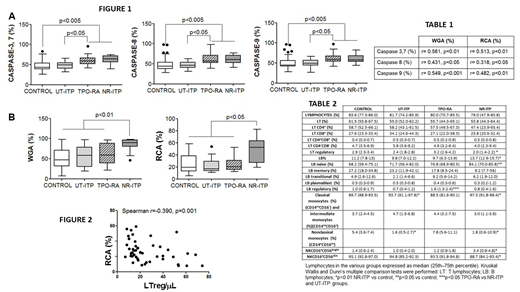Introduction: Mechanisms leading to diminished platelet counts in immune thrombocytopaenia (ITP) appear to be multifactorial: autoantibodies, autoreactive CD8+ cytotoxic T cells, enhanced apoptosis and loss of sialic acid which mediates platelet clearance through the Ashwell-Morell receptors present in hepatocytes. Differential involvement of each of them might condition the ability of patients with ITP to respond to treatments.
We aimed to examine platelet features and the immunological state of patients with ITP who do not respond to any treatment to detect the unique characteristics of this group.
Methods: This was an observational, prospective and transversal study. Patients with chronic primary ITP were included: 28 ITP patients without treatment for at least 6 months (UT-ITP); 36 responders to agonists of thrombopoietin receptors (TPO-RA); and 14 ITP patients who did not respond to first- and second-line treatments (NR-ITP). A healthy control group (n=104) was also included in the study.
Active caspase-3, -7, -8 or -9 were determined by flow cytometry using CaspaTag kits (Millipore, Madrid, Spain) in PRP diluted with HEPES-buffer containing 2 mM Ca2+ and 2 mM Gly-Pro-Arg-Pro (Sigma-Aldrich, Madrid, Spain) to prevent fibrin formation .
Platelet surface glycan exposure was analysed by determining the binding of lectins by flow cytometry. To do so, washed platelets were incubated with 1 μg/ml Alexa fluor 488-conjugated wheat germ agglutinin lectin (WGA, Invitrogen, Spain) or with 1 μg/ml FITC-conjugated Ricinus communis agglutinin (RCA, Vector Labs, UK). WGA binds to sialic acid and N-acetylglucosaminyl residues, and RCA is a galactose-specific legume lectin which binding serves as an indirect measurement of the loss of sialic acid.
Peripheral blood mononuclear cells (PBMCs) subsets were analysed by flow cytometry using specific antibodies.
Experimental data was analysed using SPSS 9.0 software (SPSS Inc., Chicago, IL).
Results: Platelets from TPO-RA treated and from NR-ITP patients had increased caspase-3, -7, -8 and -9 activities (Figure 1A).
Platelets from NR-ITP patients exposed less sialic acid and more N-acetylglucosaminyl residues than the other groups (Figure 1B). Binding of WGA and RCA correlated with caspase activities (Table 1).
Distribution of lymphocytes, monocytes and natural killer cells is shown in Table 1. NR-ITP patients had an increased proportion of B lymphocyte (LB), maybe due to a significant rise in the fraction of naive LB cells, and a diminution in LTreg subset. Whereas classical monocytes was increased, nonclassical monocyte fraction was decreased in the UT-ITP and NR-ITP groups. NR-ITP patients also presented an increased CD16+CD56bright cells fraction and a diminished NK CD16+CD56dim subset.
TPO-RA-treated patients seemed to recover an immune homeostasis similar to healthy controls (monocyte and NK cells subset distribution and LTreg count similar to control group).
It is of interest to note the relationship between loss of sialic acid from platelet surface glycans and Tregs count: the most reduced surface exposure of sialic acid, the less Treg count (Figure 2).
Conclusions:
Platelets from NR-ITP patients had more signs of apoptosis and a different composition of surface glycans, accompanied by a diminished LTreg population, a higher LB naïve percentage, and an increased CD16+CD56bright cells fraction in circulation, indicating a severe deregulation of the immune system. Since an inverse correlation was observed between loss of sialic acid and LTreg count, a potential relationship between glycan composition on the platelet surface and immune response is suggested, positing terminal sugar moieties of the glycan chains as aetiopathogenic agents in ITP.
On the other hand, TPO-RA appears to have a beneficial effect on immune response. Nevertheless, one of the limitations of our study was that patients were recruited once the response to TPO-RA was achieved; therefore, a longitudinal study would provide more information regarding TPO-RA effects.
This work was supported by grants from the FIS-FONDOS FEDER (PI15/01457, NB). NVB holds a Miguel Servet tenure track grant from FIS-FONDOS FEDER (CP14/00024).
Álvarez Roman:Roche: Consultancy, Speakers Bureau; Pfizer: Consultancy, Speakers Bureau; Bayer: Consultancy, Speakers Bureau; Novartis: Consultancy, Speakers Bureau; Amgen: Consultancy, Speakers Bureau; Takeda: Research Funding; NovoNordisk: Consultancy, Speakers Bureau; CSL Behring: Consultancy, Speakers Bureau; Sobi: Consultancy, Speakers Bureau. Fernandez-Bello:Novartis, Pfizer, ROCHE, Stago: Speakers Bureau. Martín:SOBI: Research Funding; Novartis, Pfizer, ROCHE, Novo Nordisk: Speakers Bureau. Rivas Pollmar:Novartis, Pfizer, ROCHE, Novo Nordisk: Speakers Bureau; SOBI: Research Funding. Canales:Novartis: Honoraria; Takeda: Speakers Bureau; iQone: Honoraria; Sandoz: Honoraria; Celgene: Honoraria; SOBI: Research Funding; Karyopharm: Honoraria; F. Hoffmann-La Roche Ltd: Honoraria, Speakers Bureau; Gilead: Honoraria; Janssen: Honoraria, Speakers Bureau. Jimenez-Yuste:Bayer, CSL Behring, Grifols, Novo Nordisk, Octapharma, Pfizer, Roche, Sobi, Shire: Consultancy, Honoraria, Other: reimbursement for attending symposia/congresses , Research Funding, Speakers Bureau. Butta:Novartis: Consultancy; Roche, Pfizer: Speakers Bureau.
Author notes
Asterisk with author names denotes non-ASH members.


This feature is available to Subscribers Only
Sign In or Create an Account Close Modal